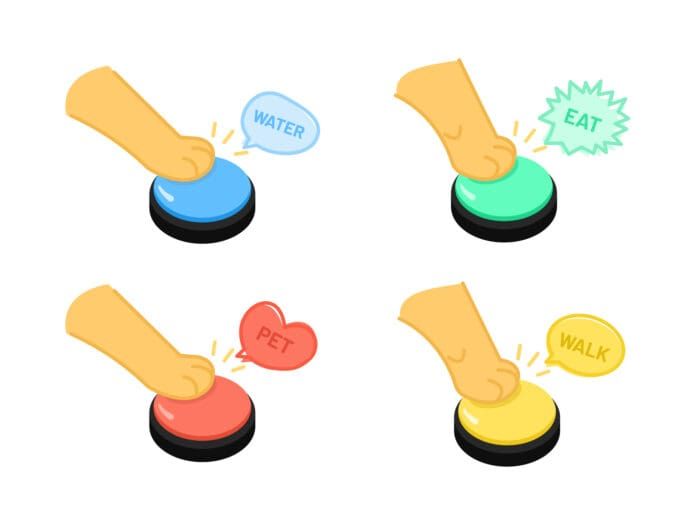The talking button craze began when speech language pathologist Christina Hunger applied the same technology she used with children to her puppy, Stella. Hunger taught nonverbal children how to use talking buttons to express and explain themselves in a Language Acquisition through Motor Planning program called Augmentative and Alternative Communication, or AAC. With practice, Stella caught on and could soon tell Hunger what she wanted or how she felt. Today, Stella knows more than 50 words and arranges them in endless combinations.
By the time her book How Stella Learned to Talk was published in 2021, Hunger and Stella had appeared in People magazine and had thousands of internet fans. Today, Hunger’s website offers information, talking buttons, accessories, online training, and instructions for dog lovers.
Followers of Hunger’s methods have produced their own books, videos, blogs, demonstrations, and appearances on social media. But are their dogs really using human language?
To examine talking buttons scientifically, Federico Rossan, director of the Comparative Cognition Lab at the University of California, San Diego, has spent four years collecting data for an independent study of dogs and talking buttons. When published, its results may settle the debate about whether dogs are truly using human speech. In the meantime, fans of talking buttons report improved relationships with happier dogs who enjoy creating meaningful word combinations.
Whole Dog Journal is reader-supported. If you purchase through links on our site we may earn a commission. Whole Dog Journal does not accept money for its food and product reviews.
Getting Started
If you’d like to try for two-way conversations with your dog, several companies sell talking-button starter kits, such as:
- Hunger for Words Talking Pet Starter Set (4 Basic Buttons, $35)
- FluentPet’s Basic Starter Kit (6 Basic Buttons, $80)
- Color Voice Recording Buttons (4 Basic Buttons, $15)
- Dog Buttons for Communication Starter Pack (4 Basic Buttons, $17)
- Talk To The Beans (speech button training program, no buttons, $30)
Not every dog is a good match for talking buttons, so consider your dog’s age, physical condition, interest in games and puzzles, and ongoing efforts to share requests or information with you. Puppies have a head start as they are constantly in learning mode and interested in trying new things, especially things that have built-in rewards, but older dogs can enjoy talking buttons, too. Pressing the buttons doesn’t require much strength or coordination, but the task can be difficult for very small breeds or dogs with physical challenges. Another consideration is your interest in serious communication, your schedule, and your willingness to add frequent training sessions to your everyday life.
As your dog’s vocabulary expands, it’s easy to add additional buttons, arranging them on a mat or board designed to hold buttons in easily accessible positions. Several talking-button resources offer do-it-yourself instructions, and some manufacturers sell boards that hold buttons securely.
Position your dog’s buttons where they are easy for him to access and not in a busy hallway or noisy part of the house. The closer and more convenient the buttons are, the more likely your dog is to try them.
Most talking buttons allow users to record short words or phrases. Popular first words for starter kits are whatever your dog hears frequently, such as “go for a walk,” “play outside,” “time to eat,” “goodbye,” “bedtime,” or “love you.”
Build Your Buttons Vocabulary
Some talking-button boards are designed to hold 30, 40, or more buttons, but the best way to start is with a single button. The more you press the button and incorporate its word into conversation with your dog, the faster she will learn to press the button herself.
To create a word list, write down the words you use most often when talking to your dog and aim for words that your dog recognizes and enjoys. Choose one to start with and don’t rush to add more words because it takes time for dogs to learn how buttons work and what they mean.
Training Strategies
On her website, Christine Hunger describes three approaches to teaching your pet to talk. The first, called Aided Language Input, models words by playing a recorded button just before or after you say its word. For example, if you want your dog to learn how to say “go outside,” you could press the “go outside” button and say, “Let’s go outside” or “Want to go outside?” and then do exactly that – go outside. Pairing words with actions that match their meaning teaches your dog what the words mean and which buttons produce them.
The second strategy is Focused Language Stimulation, also known as repetition, repetition, repetition. By focusing on a single word during short training sessions, you create opportunities to use it, and all that repetition helps your dog remember it. Hunger recommends modeling the target word dozens of times in a short period.
The third approach she describes is Increased Wait Time. This means waiting patiently while your dog figures things out. Hunger recommends pausing for 15 seconds after each statement as you talk to your pet. As she notes, some of the most successful communication has come at the end of what feels like an eternity of expectant waiting.
Talking Button Books and Support
How Stella Learned to Talk: The Groundbreaking Story of the World’s First Talking Dog by Christine Hunger (William Morrow/Harper Collins, 2021).
Teach Your Dog to Talk: A Beginner’s Guide to Training Your Dog to Communicate with Word Buttons by Stephanie Rocha (Ulysses Press, 2021).
Teach Your Dog to Speak Human: Increase Your Bond with Your Dog by Using Buttons, Soundboards, and Easy Phrases by Lacy Nelson (Kindle Edition, 2023).
The Talking Dog Journal: Track Your Dog’s Progress Learning to Use a Soundboard to Talk (Talking Dog Press, 2019).
Facebook groups devoted to this subject include:
For more on another novel method of communicating with your dog, see “Teaching Your Dog to Read.”






